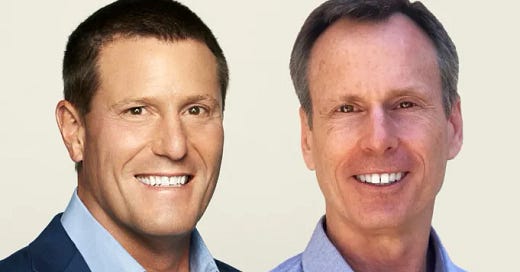The Walt Disney Company’s creative momentum has stalled. Its once-clear identity — a blend of cultural innovation and corporate discipline — has fractured under the weight of reactive strategy and panicked expansion.
And while Bob Iger’s return may have stabilized headlines, it has not solved Disney’s deeper structural problems.
Disney’s most iconic eras were shaped not by solo leadership, but by dual dynamics — complimentary forces who shared power and kept the company balanced.
Walt Disney was the visionary, the artist. But it was Roy Disney — his brother and business partner — who quietly secured the money, built the infrastructure, and kept the dream grounded in reality.
That dynamic reappeared in the 1980s with the arrival of Michael Eisner and Frank Wells. Eisner brought bold creative energy. Wells brought order and operational expertise. Under their shared tenure, the company entered a second golden age of animation, reinvented its TV business, and expanded into global parks and resorts. Analysts widely agreed: Eisner was best when Wells was alive.
Then Wells died tragically in a 1994 helicopter crash. Eisner continued alone, and almost immediately, Disney’s strategic discipline began to fray.
This brings us to Tom Staggs and Kevin Mayer — two former Disney executives who were reportedly brought back to consult Bob Iger in 2023, according to a Deadline report.
In recent years, Disney has quietly repeated the mistake of rejecting balanced leadership. Both were long-tenured executives with deep institutional experience and were widely seen as natural successors to Bob Iger. Staggs, who served as CFO and then COO, was responsible for the successful integration of Marvel and Lucasfilm and oversaw Parks and Resorts during its most profitable period. Mayer, meanwhile, led the development and acquisition of BAMTech, the backbone of Disney+, and later spearheaded the $71 billion acquisition of 21st Century Fox.
By 2016, Staggs had been elevated to COO — the clear heir apparent. But his internal ascent triggered pushback from key board members and Iger loyalists. Compounded by cost overruns and financial disappointments tied to Shanghai Disneyland, Staggs became the fall guy.
His departure signaled a deeper issue: Disney wasn’t ready to transition leadership.
Mayer’s exit followed in 2020. After being passed over for CEO in favor of Bob Chapek — a decision many now view as Iger’s greatest succession failure — Mayer quietly departed to chart his own course. What he’s built since only further underscores the missed opportunity.
Together, Staggs and Mayer co-founded Candle Media, a next-generation media company backed by Blackstone. It has rapidly assembled one of the most potent portfolios in the digital content ecosystem. Its holdings include Moonbug Entertainment (home of Cocomelon), Hello Sunshine (Reese Witherspoon’s production company), and ATTN:, a social-first Gen Z content studio.
Candle Media is a living example of how Disney could have evolved if its leaders had been allowed to fully implement their vision.
What makes this even more painful is that, on paper, another acquisition — even of Candle Media — may not be advisable. The Fox acquisition ballooned Disney’s debt and brought little in terms of brand synergy. The company cannot afford another billion-dollar mistake.
But that’s exactly the point.
This isn’t about Candle Media’s valuation — currently pegged at over $3 billion. It’s about the people who built it. Staggs and Mayer didn’t just prove they can lead. They proved they can do so without the Disney engine. And while Candle Media may not be immediately cohesive to Disney’s bottom line, it could be the long-term loss leader that corrects the company’s real deficit: a lack of leadership with both creative insight and operational discipline.
More than anything, Disney needs the balance it once had.
Disney’s problem isn’t that it lacks talent. It’s that it pushed the right talent away. Now, the company finds itself fighting battles — in streaming, in parks, in culture — without the unified leadership that made its greatest successes possible.
If Disney truly wants to reclaim its magic, it must look back — not to repeat the past, but to rediscover what always worked.
Every time Disney soared, it was under the guidance of two aligned minds.
It’s time to let history rhyme again.






Interesting how the dual-leadership model worked so well for the Disney Company. Worth returning to it if only to test this model out again. Great article.